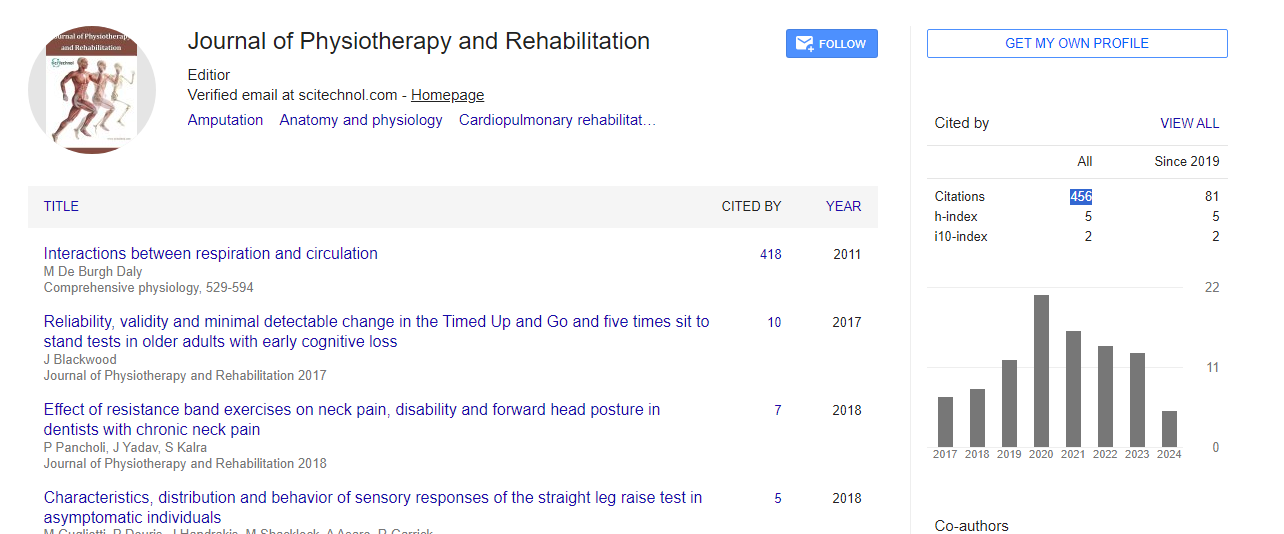Short Communication, J Physiother Rehabi Vol: 8 Issue: 4
Role of Physical Medicine in Post-Surgical Rehabilitation: Combining Evidence-Based Practices with Innovative Bio-Mechanics for Optimal Recovery
Vhris Rhipton*
1Department of Physiotherapy, University of Otago, Christchurch, Canterbury 8004, New Zealand
*Corresponding Author: Vhris Rhipton,
Department of Physiotherapy, University of
Otago, Christchurch, Canterbury 8004, New Zealand
E-mail: Rhiptonvhiri@edu.nz
Received date: 23 July, 2024, Manuscript No. JPTR-24-147324
Editor assigned date: 25 July, 2024, PreQC No. JPTR-24-147324 (PQ);
Reviewed date: 08 August, 2024, QC No. JPTR-24-147324
Revised date: 15 August, 2024, Manuscript No. JPTR-24-147324 (R);
Published date: 22 August 2024, DOI: 10.4172/JPTR.1000180.
Citation: Rhipton V (2024) Role of Physical Medicine in Post-Surgical Rehabilitation: Combining Evidence-Based Practices with Innovative Bio-Mechanics for Optimal Recovery. J Physiother Rehabi 8:4.
Description
Post-surgical rehabilitation is a critical phase in the recovery process, determining the long-term success of surgical interventions. Physical medicine plays a key role in this phase, focusing on restoring function, minimizing pain and enhancing the overall quality of life for patients. By combining evidence-based practices with innovative biomechanics, physical medicine has the potential to optimize recovery outcomes, reduce complications and accelerate the return to daily activities. Bio-mechanics the study of the mechanical laws relating to the movement or structure of living organisms has become increasingly important in the field of physical medicine. In postsurgical rehabilitation, bio-mechanics provides valuable insights into how the body moves and functions allowing for the development of more effective rehabilitation strategies [1].
One of the key applications of bio-mechanics in rehabilitation is the analysis of movement patterns and gait. After surgery, patients often experience changes in their movement patterns due to pain, weakness or altered anatomy [2]. By using bio-mechanical analysis clinicians can identify these changes and develop targeted interventions to correct them thereby improving the patient's overall function and reducing the risk of further injury [3]. For example, in patients recovering from knee replacement surgery, bio-mechanical analysis can help in assessing the alignment and movement of the knee joint during walking [4]. This information can then be used to design specific exercises and orthotic devices that promote proper joint mechanics, reduce stress on the joint and facilitate a quicker and more complete recovery [5].
The integration of evidence based practices with bio-mechanics represents a powerful approach to post-surgical rehabilitation [6]. Evidence based practices provide the foundation for safe and effective rehabilitation, while bio-mechanics offers a deeper understanding of the underlying mechanical factors that influence recovery. Together, these approaches can lead to more personalized and effective rehabilitation plans [7]. For instance in patients recovering from spinal surgery evidence-based practices such as core strengthening exercises and pain management strategies are essential for restoring function and reducing pain. However by incorporating bio-mechanical analysis clinicians can gain insights into the specific movement patterns that may be contributing to the patient's pain and dysfunction [8]. This information can then be used to modify the rehabilitation plan incorporating exercises and techniques that address the patient's unique bio-mechanical challenges [9].
The field of bio-mechanics has seen significant advancements in recent years, driven by the development of innovative technologies that allow for more accurate and detailed analysis of movement. Wearable sensors motion capture systems and force plates are just a few examples of technologies that are being used to enhance biomechanical analysis in rehabilitation [10]. Wearable sensors for instance, can be used to monitor the movement of joints in real-time, providing clinicians with valuable data on how the patient is performing their exercises and activities. This data can be used to adjust the rehabilitation plan as needed, ensuring that the patient is progressing at an appropriate pace and minimizing the risk of complications.
Conclusion
The role of physical medicine in post-surgical rehabilitation is evolving, driven by the integration of evidence based practices with innovative bio-mechanics. This approach offers a more comprehensive and personalized rehabilitation experience, leading to better outcomes for patients. The latest advancements in bio-mechanics and combining them with proven therapeutic modalities clinicians can optimize the recovery process reduce complications and help patients return to their normal activities more quickly and effectively. As the field continues to advance the integration of these approaches will likely become the standard of care in post-surgical rehabilitation providing patients with the best possible chance for a full and successful recovery.
References
- Thorbecke R, Hötger B (2001) Postsurgical rehabilitation. Epile Surg 2:891-900.
- Guarda-Nardini L, Manfredini D, Ferronato G (2008) Total temporomandibular joint replacement: A clinical case with a proposal for post-surgical rehabilitation. J Craniomaxillofac Surg 36(7):403-409.
[Crossref] [Google Scholar] [PubMed]
- Nazarieh M, Hakakzadeh A, Ghannadi S, Maleklou F, Tavakol Z, et al. (2020) Non-surgical management and post-surgical rehabilitation of Carpal Tunnel Syndrome: An algorithmic approach and practical guideline. A J Spo Med 11(3).
- Manske RC, Prohaska D (2007) Pectoralis major tendon repair post surgical rehabilitation. N Am J Sports Phys Ther 2(1):22.
[Google Scholar] [PubMed]
- Hoffman AJ, Brintnall RA, von Eye A, Jones LW, Alderink G, et al. (2014) Home-based exercise: Promising rehabilitation for symptom relief, improved functional status and quality of life for post-surgical lung cancer patients. J Thorac Dis 6(6):632.
[Google Scholar] [PubMed]
- Murvai GF, Hozan CT, Ghitea TC, Cavalu S (2023) Unlocking the secrets of post-surgical flexion: The vital role of rehabilitation in total knee arthroplasty recovery. Prosthesis 5(4):1357-1368.
- Ramelli FD (2003) Diagnosis, management and post-surgical rehabilitation of an Achilles tendon rupture: A case report. J Can Chiropr Assoc 47(4):261.
- Biancuzzi H, Dal Mas F, Bednarova R, Bongiorno G, Miceli L (2024) New Frontiers in Post-Surgical Rehabilitation. InTowards the Future of Surgery 91-97.
- Wei Y, Huang Z (2022) Effects of functional motor training on post-surgical rehabilitation of anterior cruciate ligament. Rev Bras Medi Espo 28(6):668-671.
- Donati D, Aroni S, Tedeschi R, Sartini S, Farì G, et al. (2024) Exploring the impact of rehabilitation on post-surgical recovery in elbow fracture patients: A cohort study. Musculoskelet Surg 18:1-7.
[Crossref] [Google Scholar] [PubMed]
 Spanish
Spanish  Chinese
Chinese  Russian
Russian  German
German  French
French  Japanese
Japanese  Portuguese
Portuguese  Hindi
Hindi 